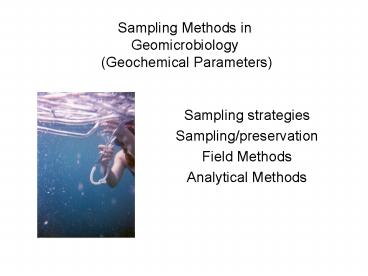Sampling Methods in Geomicrobiology Geochemical Parameters - PowerPoint PPT Presentation
1 / 18
Title:
Sampling Methods in Geomicrobiology Geochemical Parameters
Description:
C. Shallow Wells (characterization. of the water table fluctuation zone; metals, ... to stop microbial activity (e.g. Hg, Cu or Ag filters, glutaraldehyde, azide, ... – PowerPoint PPT presentation
Number of Views:263
Avg rating:3.0/5.0
Title: Sampling Methods in Geomicrobiology Geochemical Parameters
1
Sampling Methods in Geomicrobiology (Geochemical
Parameters)
Sampling strategies Sampling/preservation Field
Methods Analytical Methods
2
A
B
C
D
Methods for Water Subsurface Biogeochemistry
A. Precipitation Collector (chemical input
from the atmosphere major ions) B. Suction
Lysimeters (chemistry of vadose zone
metals, major ions and DOC) C. Shallow
Wells (characterization of the water
table fluctuation zone metals, major
ions, DOC, nitrogen and oxygen) D. Multi-Level
Long-Screened Wells (vertical chemical
structure of aquifer metals, major ions,
DOC, nitrogen and oxygen) E. Sediment
Characterization (particle size distribution,
TOC, XRD, extractable metals (Fe, Mn)
3
Sample Collection
What to sample solids (soils/seds/rocks/OM),
water (surface (lake, river), soil, or
groundwater Where and When to sample (location,
time and frequency, depth (?), volume) Pumping/con
tamination considerations
4
Water Sample Processing and Preservation
Use standard methods whenever possible! Filtratio
n 0.45µm sometimes lt0.2µm required The most
frequently used chemical preservatives are nitric
acid (HNO3), hydrochloric acid (HCl), sulfuric
acid (H2SO4), nitric acid/potassium dichromate
(HNO3/K2Cr2O7), sodium hydroxide (NaOH), or
phosphoric acid/copper sulfate (H3PO4/CuSO4). Chil
ling (to below 4ºC but not freezing) is also
utilized for nutrients, organic compounds,
chemical oxygen demand, and cyanide Poisons to
stop microbial activity (e.g. Hg, Cu or Ag
filters, glutaraldehyde, azide, formaldehyde,
Lugols solution, ethanol)
5
Common Measurement Parameters (preservation)
A. Major/minor cations and trace elements filter
and acidify to pH lt2 (usually HNO3) B. Nutrients
(nitrogen/phosphorous) filter, chill C. Major
anions filter, chill D. Organic carbon glass
container, filtered, no head space, chill
6
Field Determinations
7
Field Determinations
- Water level and T
- DO (amperometric, Winkler, or rhodazine)
- specific conductance
- reduction/oxidation potential (Eh measurement may
show qualitative trends but generally cannot be
interpreted as equilibrium values. Determinations
of redox using the platinum (or other noble
metal) electrode method (Eh) are valid only when
redox species are (a) electroactive, and (b)
present in the solution at concentrations of
about 10-5 molal and higher. Redox species in
natural waters generally do not reach equilibrium
with metal electrodes.) - alkalinity (titration).
8
Analytical Methods
A. Major cations, trace metals atomic
adsorption spetroscopy (flame (AAS) or graphite
furnace (HGAA)), inductively-coupled plasma
spectroscopy/mass spectrometry (ICP-OES, ICP-MS),
ion chromatography B. Major anions (including
organic) ion chromatography Good procedural
references Standard Methods http//www.standardme
thods.org/ www.water.usgs.gov
9
Microscopy, Mineralogy, elemental analysis
More Alphabet Soup SEM, ESEM, TEM/AEM Visual,
preparation issues (high vacuum, coating,
critical point drying) EMP, SIMS Visual,
preparation (slicing, polishing, high vacuum)
10
Microbial mats, speleothems, travertines,
laminated sediments, concretions..
Laser-ICP-MS/MC- Spatially-resolved elemental
analysis possible
11
(No Transcript)
12
Stable Isotope Analysis
H, C, O, S, N..in gas, water, biomass, solids.
13
Isotope Fractionation
Rule The atomic bonds of light isotopes are
easier to break than heavy ones. This is the
foundation for all fractionations. For example,
the light isotopes of water are more likely to
evaporate then heavy ones. Bacteria are more
likely to break the light isotope bonds of
molecules. (Light tastes great!). Isotopic
Effects (how do isotopes fractionate?)
14
Marine Isotope Record
15
(No Transcript)
16
(No Transcript)
17
(No Transcript)
18
(No Transcript)






























